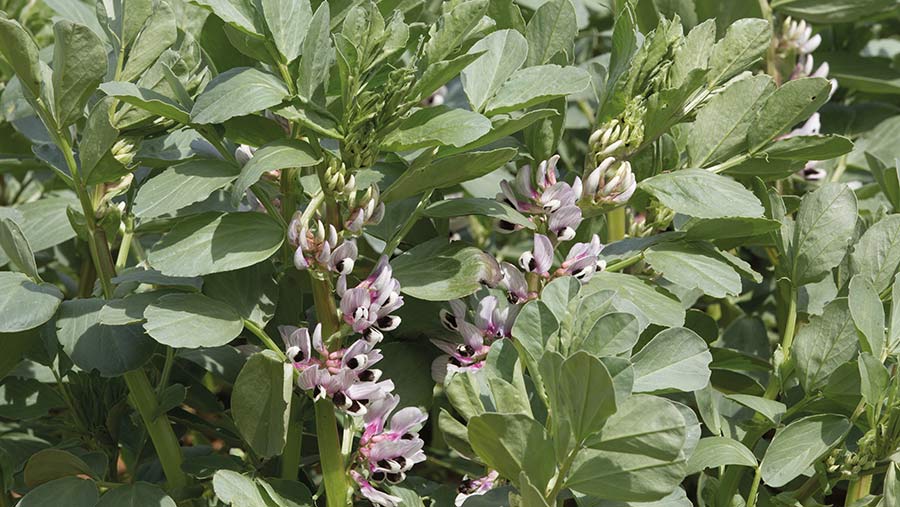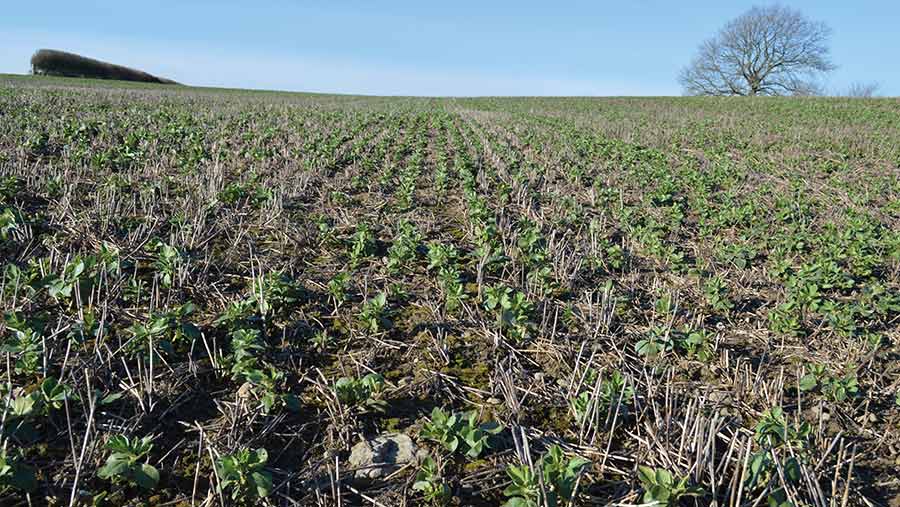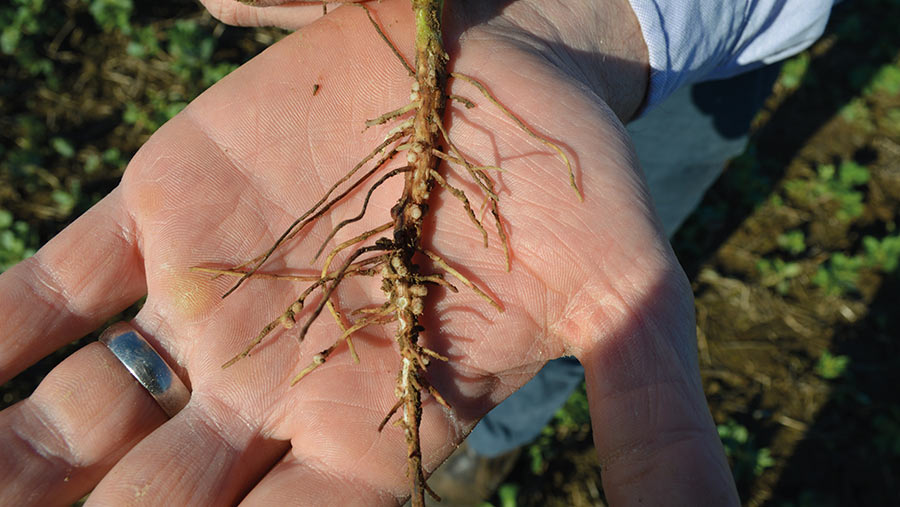Cropping beans helps Dorset grower in move to regen farming
 © Tim Scrivener
© Tim Scrivener Beans are an ideal move towards regenerative farming for Dorset grower and contractor George Fraser. The crop is well suited to direct-drilling, requires few inputs and improves the structure and fertility of his soils.
His bean crops along the Dorset/Wiltshire border are producing impressive profit margins and cutting slug problems, while he is able to reduce nitrogen fertiliser in his following winter wheat crops.
On his chalky soils, winter beans are favoured over spring beans to cope with any summer drought. But his spring-sown crops surprised him in 2022 with exceptional yields.
See also: Beans make reliable and low-input break crop for arable farm
Both crops established using no-tillage and, with minimum inputs, they have a low carbon footprint.
“We needed to extend our rotations, spread out oilseed rape crops, and bring in another break crop to improve soil health, and beans were the obvious choice,” he tells Farmers Weekly.
Summer drought
Mr Fraser’s family-run A&R Fraser farms and contract farms 1,200ha of arable land from its base at Braeside Farm, Charlton, about two miles east of Shaftesbury.
Winter beans yielded up to 6t/ha in 2022 and spring beans averaged 4t/ha despite the summer drought and heatwave.
His preference for winter beans is due to their lower inputs costs and higher yields compared with the spring crop, and his gross margins for the autumn-sown crops are more than £1,200/ha.
The use of no-ploughing techniques, low inputs, no nitrogen fertiliser and low slug numbers in the following winter wheat crops mean that beans are helping with his move towards regenerative farming, with a clear focus on soil health.
His agronomist, Todd Jex – who works for agronomy group Agrii covering Dorset and Wiltshire – says that bean crops are very well suited to direct-drilling.
The winter and spring beans thrive when grown after a catch or cover crop.
“We need two break crops to extend rotations, and when agronomics and gross margins are considered, beans are the second best break crop after oilseed rape,” he says.

© MAG/David Jones
Direct drilling
Mr Jex points out that beans give a better yield when direct-drilled rather than in a plough-based system.
Beans show no short-term yield dilution which often happens when switching to direct-drilling for cereals.
In addition, beans can be a less stressful crop than oilseed rape to grow. They have proved to show less variable yields than often thought, with winter beans’ variable costs being about half those of OSR.
Mr Fraser’s winter bean area was cut to 20ha in 2022 due to rotational reasons, and his average yield was 5t/ha with a top of 6t/ha. However, this season he is growing an expanded area of 250ha.
Winter beans often follows winter wheat, and the variety Vespa is drilled between mid-October and mid-November with a 6m Weaving GD direct drill at 20 seeds/sq m and then rolled.
The bean crop is often preceded by a catch crop of fast-growing buckwheat, which helps to mine phosphate from the soil, and occasionally phacelia is used.
Some 50% of the cover, catch and bean crops are drilled with the Weaving GD.
The other 50% is with a 8m Weaving Sabre tine drill, depending on the soil type and conditions.
Input strategy
A pre-emergence herbicide mix of propyzamide (Kerb), together with imazamox + pendimethalin (Nirvana) and clomazone (Centium) is applied, and a spring graminicide is used if needed.
Polysulphate is then applied in the spring, supplying sulphur, potassium and magnesium.
Disease strategy is based around two fungicides, one at the start of flowering and the second at podding.
A mix of SDHI benzovindiflupyr and azole prothioconazole (Elatus Era) is generally used at the first timing for its good control of chocolate spot.
A mix of strobilurin azoxystrobin (Amistar) and azole tebuconazole is used at the second timing for its effectiveness against rusts.
Tissue tests are taken every two to three weeks for winter and spring crops in the main growing season.
Molybdenum, boron and manganese can be applied along with phosphite as a bio-stimulant if needed, which can help the crop overcome downy mildew and stress.
These are generally applied with a fungicide if the timing is appropriate.
The winter beans variable costs come in at £240/ha. With an average yield of 5t/ha selling at about £300/t for the animal feed market, it gives a respectable gross margin of £1,260/ha.
Surprising spring beans
The real surprise last season came with good yields of spring beans. Some 100ha of the variety Lynx were drilled in late February with an Amazone Cayena 8m tined direct drill and rolled.
The crops established and rooted well helped by the early drilling, warming soils and some rain in March and April.
The beans followed cover crops of buckwheat, phacelia, vetch, crimson clover and linseed.
Sunflowers were included to assist with soil compaction alleviation. These replaced brassicas, such as forage rape, mustard or oils radish, due to OSR being in the rotation and to prevent slugs for the following wheat crop.
The cover crops were sprayed off with glyphosate relatively late, at the end of January, so as not to completely destroy the crop before the beans were drilled, and leave a good level of trash to help keep the soil healthy.
Mr Jex says cover crops are key to keeping the carbon-nitrogen ratio high. The carbon feeds microbes in the soil and assists nodulation, allowing the bean crop to produce its own nitrogen.
As with the winter beans, no phosphate is applied, but sulphur is added and the same herbicide combination is used minus the propyzamide, and a similar fungicide regime.
Variable costs for the spring beans come in about £360/ha, due to the higher seed rate of 55 seeds/sq m needed as there is less branching in the spring crop compared with autumn ones.
An average 4t/ha bean crop sold at £300/t gives a gross margin between £800-£900/ha.

Nodules on a bean root © MAG/David Jones
Four fields
Mr Fraser was particularly impressed with four fields of spring beans grown in south Wiltshire on a shallow flinty chalk, which showed yields between 4.1-4.9t/ha.
“The crops established well during March and April and performed surprisingly well after the drought started to hit at the end of April,” he says.
Bean crops will struggle to compete financially with oilseed rape, but with the desire to widen oilseed rape’s presence in the rotation to a minimum of every four to five years, there is a need for a second break crop.
In addition, spring beans can be useful if there is winter germinating blackgrass to control on the farm.
“Beans are a positive for the rotation. They leave nitrogen in the soil for the next winter wheat crop, reduce slug problems and lead to better and faster wheat establishment,” says Mr Jex.
Agrii seed specialist Will Sanderson says there have been more enquiries about seed for this pulse crop.
“We have seen more interest for winter and spring bean seed, especially winter bean, this season,” he says.

